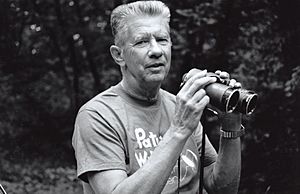Chandler Robbins facts for kids
Quick facts for kids
Chandler Robbins
|
|
|---|---|

Chandler Robbins, in the field
|
|
| Born | July 17, 1918 |
| Died | March 20, 2017 (aged 98) Columbia, Maryland, U.S.
|
| Nationality | American |
| Alma mater | Harvard University, George Washington University |
| Known for | North American Breeding Bird Survey, Birds of North America: A Guide to Field Identification |
| Scientific career | |
| Fields | Ornithology |
| Institutions | Patuxent Wildlife Research Center |
Chandler Seymour Robbins (born July 17, 1918 – died March 20, 2017) was an American ornithologist. An ornithologist is a scientist who studies birds. He helped create an important guide to birds. He also started a big project called the North American Breeding Bird Survey. This project helps track bird populations across the continent.
Contents
Early Life and Education
Chandler Robbins was born in Belmont, Massachusetts. He went to Harvard University and earned a degree in 1940. Later, he received his master's degree from George Washington University in 1950.
A Career Helping Birds
After college, Chandler Robbins taught for a few years. During World War II, he joined the Civilian Public Service instead of serving in the military. In 1943, he started working at the Patuxent Wildlife Research Center in Maryland. He joined the U.S. Fish and Wildlife Service (USFWS) full-time in 1945.
Protecting Birds from Pesticides
Early in his career, Robbins studied how a pesticide called DDT affected bird populations. His work, along with other scientists, helped show the dangers of DDT. This research was important for Rachel Carson's famous book, Silent Spring. This book helped lead to DDT being banned in the U.S.
Studying Birds in Their Homes
Robbins made big contributions to studying birds in their natural environments. He found new ways to measure things about birds. He also studied how breaking up large forests into smaller pieces, called forest fragmentation, affected birds. His research helped Maryland create rules to protect the Chesapeake Bay area. Robbins was most proud of his work to save large, unbroken forests.
He traveled to many places for his research. He worked in the mid-Atlantic U.S., in Latin America, and on Midway Island. On Midway Island in 1956, Robbins banded a Laysan albatross named Wisdom. Banding means putting a small, numbered band on a bird's leg. This helps scientists track birds. As of 2021, Wisdom is at least 70 years old. She is the oldest known wild bird. Robbins loved bird banding. He banded over 190,000 individual birds of more than 300 different species.
The North American Breeding Bird Survey
One of Robbins's most important achievements was creating the North American Breeding Bird Survey (BBS). This survey helps scientists count birds across North America. It uses skilled volunteers who count birds along roadsides. This method made it possible to track bird populations efficiently for the first time. The BBS started in Maryland and Delaware in 1965. It then spread across the entire country.
International Bird Protection
In the mid-1940s, Robbins helped coordinate a program that collected bird migration records. These records helped track how birds move across the continent.
Robbins was also chosen to help negotiate a treaty with the Soviet Union. This treaty, signed in 1976, aimed to protect birds that migrate between the two countries.
Writing and Editing for Bird Lovers
Robbins was an editor for Maryland Birdlife for many years. He also edited Audubon Field Notes/North American Birds. He wrote or co-wrote over 650 papers, books, and maps about birds.
In 1966, Robbins co-wrote a very popular book called Birds of North America: A Guide to Field Identification. It was often called the "Golden Guide." This book was special because it showed text, pictures, maps, and bird shapes all on two-page spreads. It also showed more bird plumages (feather patterns) in better detail than older guides. The book even used sonograms. These are special graphs that show bird calls visually. Most of these sonograms came from Robbins's own recordings. Millions of copies of this book were sold.
Working with Citizen Scientists
Chandler Robbins understood that many people loved birds and wanted to help. He worked with these "citizen scientists" to gather information. These volunteers had good bird identification skills and used his field guide. They followed the BBS rules to collect data. Robbins was very good at organizing all this information. He turned it into valuable knowledge that helped with bird conservation in North America.
Awards and Recognition
Chandler Robbins received many awards for his work.
- In 1987, he received the Eisenmann Medal and the U.S. Department of the Interior's Distinguished Service Award.
- He also received awards from the American Birding Association and the National Wildlife Federation.
- In 2000, he received the Audubon Medal from the National Audubon Society.
- In 2015, he received the Roger Tory Peterson Award for his lifetime work in birding.
- The University of Maryland gave him an honorary Doctor of Science degree in 1995.
In 2000, the American Birding Association created the Chandler Robbins Award. This award honors people who help educate birders or protect birds. A biological station in Guatemala was also named in his honor.
Later Life and Passing
After 60 years of public service, Robbins retired from the Patuxent Wildlife Research Center in 2005. He continued to volunteer at the Bird Banding Lab several times a week.
Chandler Robbins passed away on March 20, 2017, in Columbia, Maryland. He was 98 years old. He is remembered for his huge impact on bird science and conservation.
Images for kids


